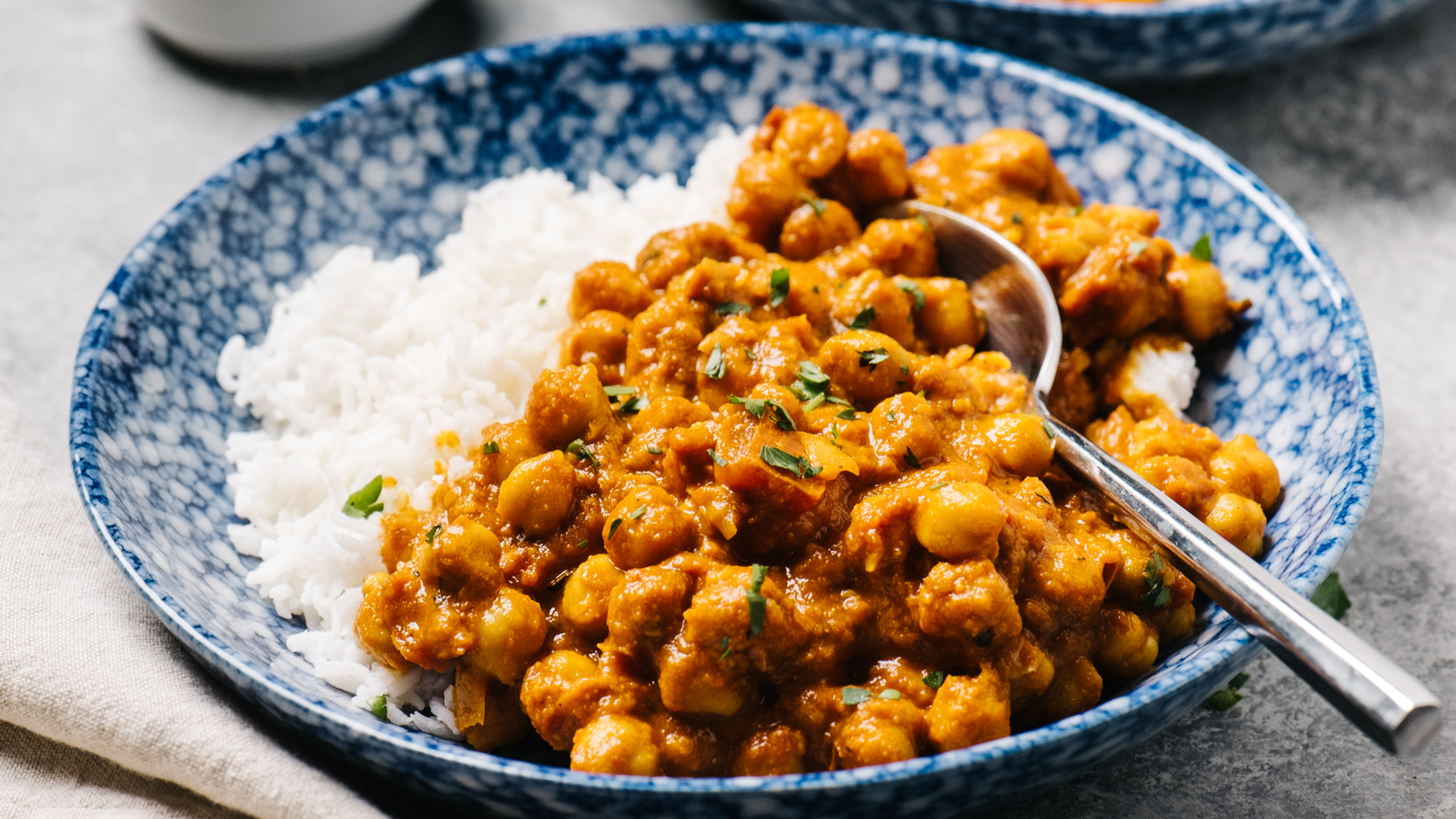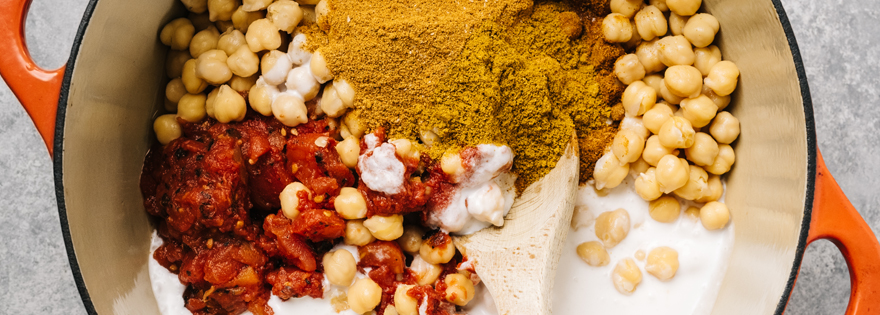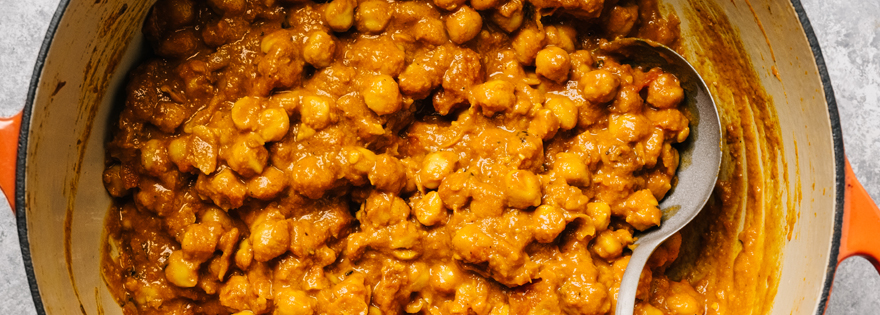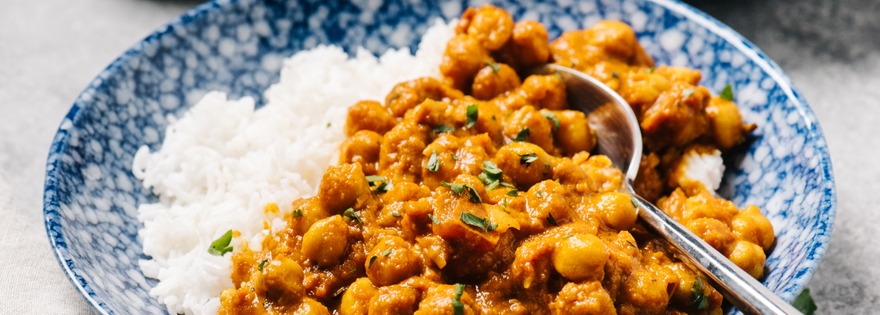
Chickpea Tandoori with Rice
By Patrik Baboumian (@patrikbaboumian)
The first time I had this dish was over five years ago at an Indian restaurant in Charlottenburg, Germany. My wife Katy and I went there together – and since then, we’ve taken several others and have frequented the restaurant countless times, largely because I had fallen in love with this meal. It reminds me of my mom and my Persian roots growing up in Iran, which influences a lot of the meals we make today. In our house, our meals tend to be a blend of Chinese, Asian, sometimes Indian and Persian flavors, with some German recipes sprinkled in that Katy brings from her background.
I was born in Iran, but ethnically I’m Armenian – so when it comes to food, my whole family is very influenced by the Persian cuisine. Growing up, I remember a lot of stews with legumes and a number of meat dishes. But what I always thought was cool is that even though meat was used in most of the dishes, the meat was rarely the main focus – it doesn’t play the leading role. So, when I decided to go vegetarian, it made my transition a lot easier because meat was purely a source of protein. Removing meat from the dishes I grew up eating didn’t change the integrity of the meal or the taste; all I needed to do was find an alternative protein, like chickpeas.
Katy and I fully embrace the vegan lifestyle – and this dish is one of our staple menu items. It’s everything I love in a good meal – delicious, easy-to-make and full of protein. Just writing about it now makes me really hungry for it! The way this dish is traditionally made often contains ghee – or dairy fat – but to make it vegan, we substitute the ghee with both coconut milk and a plant-based margarine like Rama to achieve the same level of fat content throughout the dish.
When it comes to cooking, we prioritize keeping our meals interesting and making the cooking process a great experience – all of which is captured in this recipe. I hope you enjoy making (and eating) this meal as much as I do!
DID YOU KNOW? Chickpeas are a type of legume that have a much lower carbon footprint compared to most meat-based protein sources. Using chickpeas instead of beef in 4 servings of Patrik’s recipe saves 133 kg CO2-eq. This is the carbon footprint equivalent to cycling 534 km rather than driving an average petrol car.
*Based on published researchReducing food’s environmental impacts through producers and consumers, by J. Poore & T. Nemecek. 2018.
For more information see https://upfield.com/purpose/environmental-footprint/
Ingredients
- 900g or 3.5 cups basmati rice
- a pinch of salt
- 50g or 1/3 cup Rama 100% plant-based margarine
- 4 cans of chickpeas; drained; approx. 900g
- 1 can of coconut milk; approx. 400ml
- 1 can of diced tomatoes; approx. 400g
- 40g or 5 tbsp tomato paste
- 50g or 6 tbsp Tandoori seasoning (vegan)
- 6g or 3 tsp curry powder
- 4g or 2 tsp chili powder
- 10ml or 2 tsp vegetable broth (vegan)
Instructions
(time est. approx. 1 hour 40 minutes)
- Rinse the loose basmati rice.
- Add the rice to rice cooker or large pot and fill with approximately 800ml or 3.5 cups of water.
- Whether using a rice cooker or pot, set to medium heat, bring rice to boil or until hot.
- Once the water is boiling or hot, stir in the salt and mix the Rama evenly throughout the rice.
- Reduce the heat to low, cover with a lid (if using a pot), and let the rice slowly cook until done or until all of the water has evaporated (approx. 1 hour).
- While the rice cooks, clean and rinse the chickpeas thoroughly with water, then strain them.
- Add all ingredients into a large nonstick pot.
- Over high heat cook all the added ingredients until the liquids are mostly vaporized. And don’t forget to stir everything occasionally!
- Cover the pot with a lid, reduce heat slightly, and cook for another 30-40min until all liquids are vaporized, stirring occasionally. (Note: The Chickpea Tandoori should have a rich orange color, which indicates that it is well-seasoned.)
- Serve the chickpea tandoori over the rice, and enjoy!
A diet that is mostly made up of plants is better for you and for the planet.
Click here to challenge yourself and others to go plant-based for a day for #ABetterPlantBasedFuture
Follow us on Instagram for inspiration and tips on how to go plant-based, share photos of your plant-based meals and join the movement for #ABetterPlantBasedFuture.





